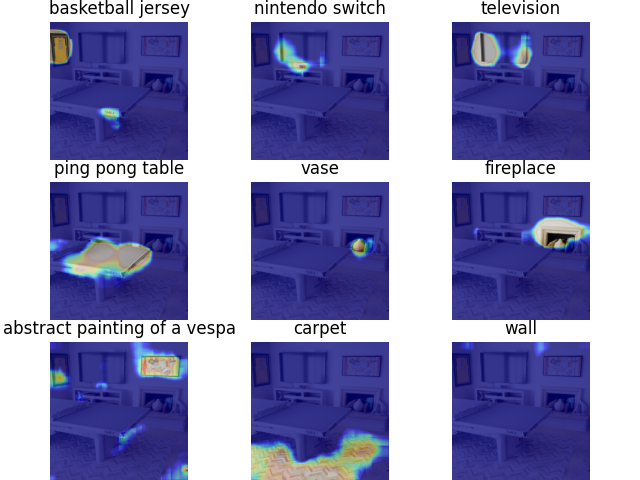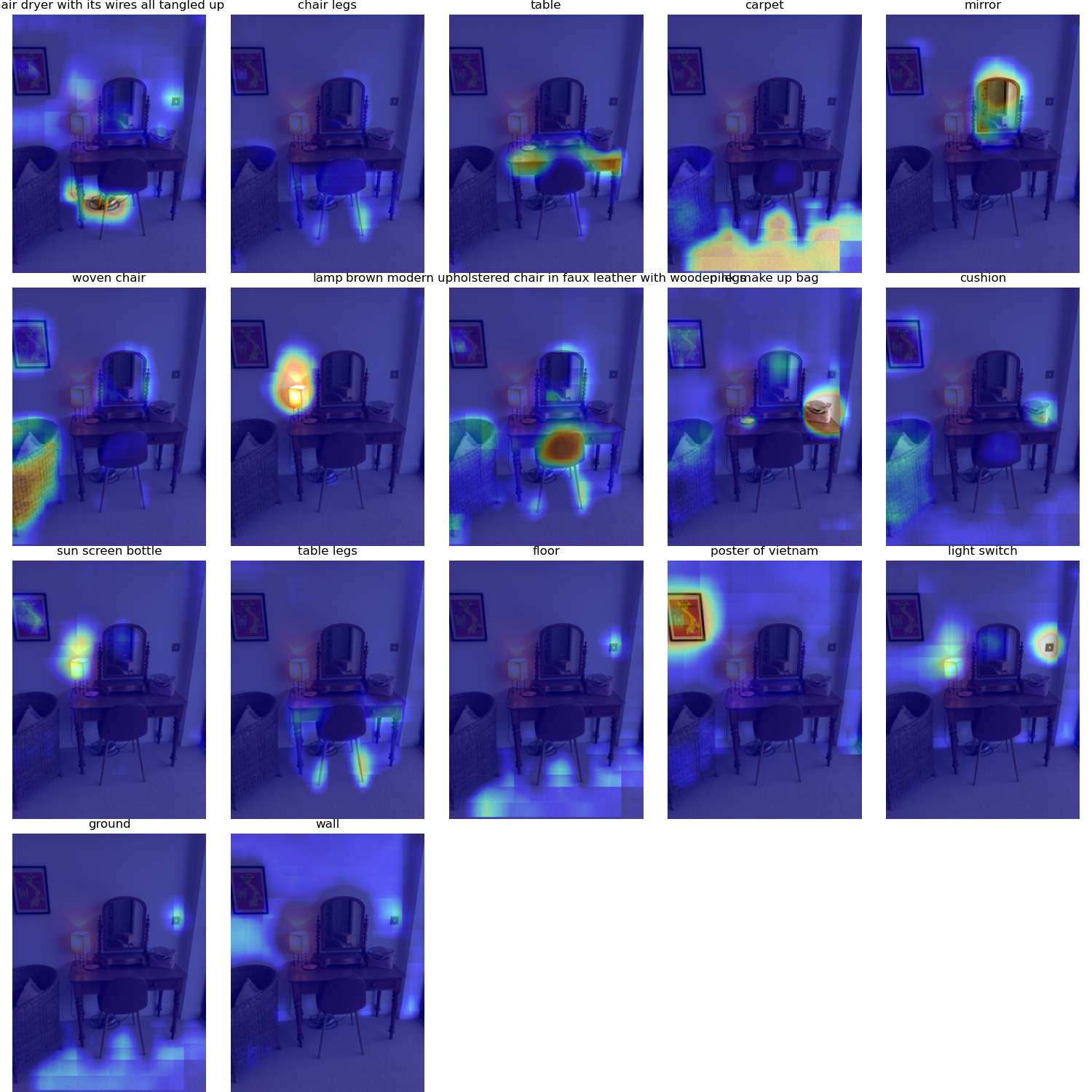Columbia University, New York, NY, United States
Conference on Robot Learning 2022

Our approach, Semantic Abstraction, unlocks 2D VLM's capabilities to 3D scene understanding. Trained with a limited synthetic dataset, our model generalizes to unseen classes in a novel domain (i.e., real world), even for small objects like “rubiks cube”, long-tail concepts like “harry potter”, and hidden objects like the “used N95s in the garbage bin”. Unseen classes are bolded.
This repository contains code for generating relevancies, training, and evaluating Semantic Abstraction. It has been tested on Ubuntu 18.04 and 20.04, NVIDIA GTX 1080, NVIDIA RTX A6000, NVIDIA GeForce RTX 3080, and NVIDIA GeForce RTX 3090.
If you find this codebase useful, consider citing:
@inproceedings{ha2022semabs,
title={Semantic Abstraction: Open-World 3{D} Scene Understanding from 2{D} Vision-Language Models},
author = {Ha, Huy and Song, Shuran},
booktitle={Proceedings of the 2022 Conference on Robot Learning},
year={2022}
}If you have any questions, please contact me at huy [at] cs [dot] columbia [dot] edu.
Table of Contents
Create the conda environment
conda env create -f semabs.ymlDownload the model checkpoints (~3.5GB) by running this command at the root of the repo
wget https://semantic-abstraction.cs.columbia.edu/downloads/models.tar.lz4 -O - | tar --use-compress-program=lz4 -xf - -C ./ You should have the following directory structure
❯ tree /path/to/semantic-abstraction/models
/path/to/semantic-abstraction/models
├── chefer_et_al
│ ├── ovssc
│ │ ├── args.pkl
│ │ ├── ovssc.pth
│ │ └── ovssc_eval_stats.pkl
│ └── vool
│ ├── args.pkl
│ ├── vool.pth
│ └── vool_eval_stats.pkl
├── clipspatial
│ └── vool
│ ├── args.pkl
│ ├── vool.pth
│ └── vool_eval_stats.pkl
├── ours
│ ├── ovssc
│ │ ├── args.pkl
│ │ ├── ovssc.pth
│ │ └── ovssc_eval_stats.pkl
│ └── vool
│ ├── args.pkl
│ ├── vool.pth
│ └── vool_eval_stats.pkl
└── semaware
├── ovssc
│ ├── args.pkl
│ ├── ovssc.pth
│ └── ovssc_eval_stats.pkl
└── vool
├── args.pkl
├── vool.pth
└── vool_eval_stats.pkl
11 directories, 21 filesTo run the evaluation inference or training, you will need the dataset.
Download the dataset (~269GB) by running the following at the root of the repo
wget https://semantic-abstraction.cs.columbia.edu/downloads/dataset.tar.lz4 -O - | tar --use-compress-program=lz4 -xf - -C ./We also preprocessed the (~53GB) NYU dataset for training and evaluation
wget https://semantic-abstraction.cs.columbia.edu/downloads/nyu_ovssc.tar.lz4 -O - | tar --use-compress-program=lz4 -xf - -C ./Play around with the multi-scale relevancy extractor on 
To run the multi-scale relevancy on GPU locally with the provided image from matterport
python generate_relevancy.py imagewhich will output
Try passing in your own image!
❯ python generate_relevancy.py image --help
Usage: generate_relevancy.py image [OPTIONS] [FILE_PATH]
Generates a multi-scale relevancy for image at `file_path`.
╭─ Arguments ───────────────────────────────────────────────────────────────────────────────────╮
│ file_path [FILE_PATH] path of image file [default: matterport.png] │
╰───────────────────────────────────────────────────────────────────────────────────────────────╯
╭─ Options ─────────────────────────────────────────────────────────────────────────────────────╮
│ --labels TEXT list of object categories (e.g.: "nintendo switch") │
│ [default: basketball jersey, nintendo switch, television, ping pong │
│ table, vase, fireplace, abstract painting of a vespa, carpet, wall] │
│ --prompts TEXT prompt template to use with CLIP. │
│ [default: a photograph of a {} in a home.] │
│ --help Show this message and exit. │
╰───────────────────────────────────────────────────────────────────────────────────────────────╯The evaluation result dataframes (*_eval_stats*.pkl) are provided along with the model checkpoints.
To summarize them in a table
❯ python summarize.py
OVSSC THOR
╷ ╷ ╷ ╷
Approach │ Novel Room │ Novel Visual │ Novel Vocab │ Novel Class
═════════════════════════╪════════════╪══════════════╪═════════════╪═════════════
Semantic Aware │ 32.2 │ 31.9 │ 20.2 │ 0.0
SemAbs + [Chefer et al] │ 26.6 │ 24.3 │ 17.8 │ 12.2
─────────────────────────┼────────────┼──────────────┼─────────────┼─────────────
Ours │ 40.1 │ 36.4 │ 33.4 │ 37.9
╵ ╵ ╵ ╵
FULL VOOL THOR
╷ ╷ ╷ ╷ ╷
Approach │ Spatial Relation │ Novel Room │ Novel Visual │ Novel Vocab │ Novel Class
═════════════════════════╪══════════════════╪════════════╪══════════════╪═════════════╪═════════════
Semantic Aware │ in │ 15.0 │ 14.7 │ 7.6 │ 1.8
│ on │ 9.0 │ 8.9 │ 11.4 │ 4.5
│ on the left of │ 11.2 │ 11.1 │ 14.4 │ 4.0
│ behind │ 12.8 │ 12.6 │ 14.1 │ 2.2
│ on the right of │ 13.1 │ 13.0 │ 11.5 │ 3.4
│ in front of │ 11.2 │ 11.1 │ 9.3 │ 2.2
│ mean │ 12.1 │ 11.9 │ 11.4 │ 3.0
─────────────────────────┼──────────────────┼────────────┼──────────────┼─────────────┼─────────────
ClipSpatial │ in │ 9.6 │ 8.6 │ 7.1 │ 3.3
│ on │ 14.1 │ 12.1 │ 18.5 │ 20.0
│ on the left of │ 11.0 │ 9.4 │ 14.2 │ 13.2
│ behind │ 11.3 │ 9.9 │ 14.1 │ 8.9
│ on the right of │ 12.1 │ 10.6 │ 16.2 │ 11.5
│ in front of │ 12.3 │ 10.3 │ 15.7 │ 9.9
│ mean │ 11.7 │ 10.1 │ 14.3 │ 11.2
─────────────────────────┼──────────────────┼────────────┼──────────────┼─────────────┼─────────────
SemAbs + [Chefer et al] │ in │ 11.8 │ 11.1 │ 5.7 │ 2.1
│ on │ 7.0 │ 6.7 │ 11.3 │ 7.1
│ on the left of │ 9.5 │ 9.3 │ 13.7 │ 4.9
│ behind │ 7.6 │ 7.6 │ 10.6 │ 2.5
│ on the right of │ 9.2 │ 9.2 │ 11.0 │ 3.9
│ in front of │ 9.4 │ 9.0 │ 12.0 │ 3.3
│ mean │ 9.1 │ 8.8 │ 10.7 │ 4.0
─────────────────────────┼──────────────────┼────────────┼──────────────┼─────────────┼─────────────
Ours │ in │ 17.8 │ 17.5 │ 8.5 │ 7.3
│ on │ 21.0 │ 18.0 │ 27.2 │ 28.1
│ on the left of │ 22.0 │ 20.3 │ 27.7 │ 25.1
│ behind │ 19.9 │ 18.0 │ 22.8 │ 16.7
│ on the right of │ 23.2 │ 21.7 │ 28.1 │ 22.1
│ in front of │ 21.5 │ 19.4 │ 25.8 │ 19.1
│ mean │ 20.9 │ 19.2 │ 23.4 │ 19.7
OVSSC NYU
╷ ╷ ╷ ╷ ╷ ╷ ╷ ╷ ╷ ╷ ╷ ╷
Approach │ Ceiling │ Floor │ Wall │ Window │ Chair │ Bed │ Sofa │ Table │ Tvs │ Furn │ Objs │ Mean
═══════════════════╪═════════╪═══════╪══════╪════════╪═══════╪══════╪══════╪═══════╪══════╪══════╪══════╪══════
Ours (Supervised) │ 22.6 │ 46.1 │ 33.9 │ 35.9 │ 23.9 │ 55.9 │ 37.9 │ 19.7 │ 30.8 │ 39.8 │ 27.7 │ 34.0
───────────────────┼─────────┼───────┼──────┼────────┼───────┼──────┼──────┼───────┼──────┼──────┼──────┼──────
Ours (Zeroshot) │ 13.7 │ 17.3 │ 13.5 │ 25.2 │ 15.2 │ 33.3 │ 31.5 │ 12.0 │ 23.7 │ 25.6 │ 19.9 │ 21.0
╵ ╵ ╵ ╵ ╵ ╵ ╵ ╵ ╵ ╵ ╵ ╵ To run inference, make sure the dataset is downloaded.
Then, regenerate the evaluation result dataframes by running the evaluation script.
For OVSSC
python -m torch.distributed.run --nnodes=1 --nproc_per_node=1 eval.py --task ovssc --file_path dataset/ --gpus 0 --load models/ours/ovssc/ovssc.pthInference can be sped up by using more than one GPU.
For instance, to use GPU 0, 1, 2, and 3, use --nproc_per_node=4 and --gpus 0 1 2 3.
For OVSSC on NYU
python -m torch.distributed.run --nnodes=1 --nproc_per_node=1 eval.py --task ovssc --file_path nyu_ovssc/ --gpus 0 --load models/ours/ovssc/ovssc.pthSimilarly, for VOOL
python -m torch.distributed.run --nnodes=1 --nproc_per_node=1 eval.py --task vool --file_path dataset/ --gpus 0 --load models/ours/vool/vool.pthThe visualize.py script takes as input the scene pickle file and the network checkpoint.
The pickle file should be a dictionary with the following keys and types
rgb: np.ndarray # shape h x w x 3
depth: np.ndarray # shape h x w
img_shape: Tuple[int, int]
cam_intr: np.ndarray # shape 4 x 4
cam_extr: np.ndarray # shape 4 x 4
ovssc_obj_classes: List[str]
descriptions: List[List[str]]After being loaded, rgb and depth will be resized to img_shape, which matches the image dimensions in cam_intr.
Each element in descriptions is a list containing the target object name, spatial preposition and reference object name respectively.
We provide some example scene pickle files from Habitat Matterport 3D and ARKitScenes in scene_files/.
Visualizing OVSSC generates a .mp4 video of the completion, along with .obj meshes, while visualizing VOOL generates .mp4 videos along with .ply pointclouds for each description.
For instance, running
# OVSSC
python visualize.py ovssc-inference scene_files/arkit_vn_poster.pkl models/ours/ovssc/ovssc.pth
python visualize.py ovssc-visualize visualization/arkit_vn_poster
# VOOL
python visualize.py vool-inference scene_files/arkit_vn_poster.pkl models/ours/vool/vool.pth
python visualize.py vool-visualize visualization/arkit_vn_posterWill output to visualization/arkit_vn_poster, including the following relevancies
and the following VOOL localization for the hair dryer with its wires all tangled up behind the table legs and OVSSC completion:
| RGB | Localization | Completion |
|---|---|---|
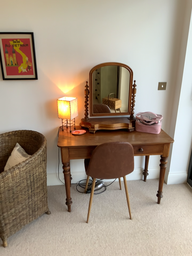 |
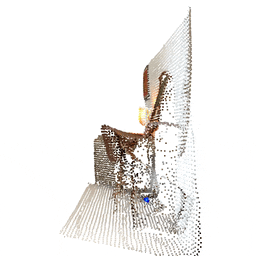 |
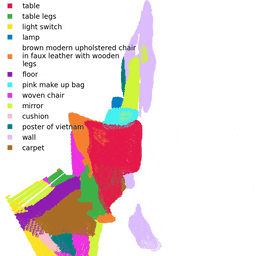 |
While these visualizations are sufficient for debugging, I recommend using the ply and obj files to render in Blender.
| Legend | Localization |
|---|---|
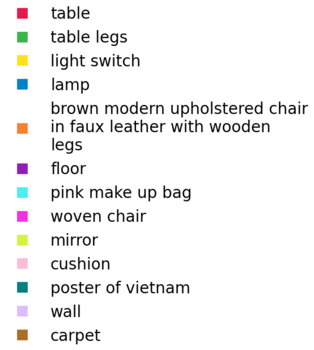 |
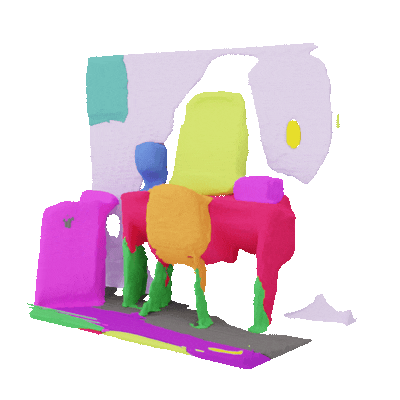 |
To train the models, make sure the dataset is downloaded.
To retrain our model
python -m torch.distributed.run --nnodes=1 --nproc_per_node=8 train_ovssc.py --file_path dataset/ --log models/new-ours --gpus 0 1 2 3 4 5 6 7 --epochs 200 --saliency_config oursTo retrain the semantic aware model
python -m torch.distributed.run --nnodes=1 --nproc_per_node=8 train_ovssc.py --file_path dataset/ --log models/new-ours --gpus 0 1 2 3 4 5 6 7 --epochs 200 --approach semantic_awareTo retrain the semantic abstraction + Chefer et. al model
python -m torch.distributed.run --nnodes=1 --nproc_per_node=8 train_ovssc.py --file_path dataset/ --log models/new-ours --gpus 0 1 2 3 4 5 6 7 --epochs 200 --approach semantic_awareTo retrain our model
python -m torch.distributed.run --nnodes=1 --nproc_per_node=8 train_vool.py --file_path dataset/ --log models/new-ours --gpus 0 1 2 3 4 5 6 7 --epochs 200 --saliency_config oursTo retrain the semantic aware model
python -m torch.distributed.run --nnodes=1 --nproc_per_node=8 train_vool.py --file_path dataset/ --log models/new-ours --gpus 0 1 2 3 4 5 6 7 --epochs 200 --approach semantic_awareTo retrain the CLIP-Spatial model
python -m torch.distributed.run --nnodes=1 --nproc_per_node=8 train_vool.py --file_path dataset/ --log models/new-ours --gpus 0 1 2 3 4 5 6 7 --epochs 200 --approach clip_spatial
To retrain the semantic abstraction + Chefer et. al model
python -m torch.distributed.run --nnodes=1 --nproc_per_node=8 train_vool.py --file_path dataset/ --log models/new-ours --gpus 0 1 2 3 4 5 6 7 --epochs 200 --approach semantic_awareBelow, we've provided a summary of the networks provide, along with how and where our method as described in the paper is implemented. The links in the bullet points below links to specific lines in this codebase. We hope this code annotation helps clarify the network architecture and training procedures.
-
SemAbs3D: This class implements the SemAbs module. It contains two networks, aResidualUNet3D(i.e,$f_\mathrm{encode}$ ) and anImplicitVolumetricDecoder(i.e,$f_\mathrm{decoder}$ ). -
SemanticAwareOVSSC: This class implements the SemAware baseline in the OVSSC task. It inherits directly fromSemAbs3D, with two crucial differences: 1) it takes RGB pointclouds as input instead of saliency pointclouds, and ) it uses its sampled feature pointclouds to point to text features of semantic classes (i.e., encoded using CLIP's text encoder). These two differences together mean it has to learn to recognize semantic classes from RGB inputs by itself, which leads to overfitting of training semantic classes. -
SemAbsVOOL: This class implements the SemAbs module for the VOOL task. In addition to the learnable parameters ofSemAbs3D, it includes a set of relational embeddings, one for each of the close-vocabulary of spatial relations. -
SemanticAwareVOOL: This class implements the SemAware baseline for the VOOl task. Similar toSemanticAwareOVSSC, it takes as input RGB pointclouds. However, specifically for the VOOl task, it uses the entire localization description (encoded using CLIP's text encoders and learned spatial relations) to point to regions within the scene. -
ClipSpatialVOOL: This class implements the CLIPSpatial baseline for the VOOL task. In contrast to other VOOL networks, it does not attempt to learn spatial relations or semantics. Instead, it completely relies on relevancy inputs from CLIP.
A few tips for training your semantic abstraction module:
- We have observed that performing small random transformations on input and output point clouds help generalization significantly.
- To account for positive/negative class balance when using the binary cross entropy loss (in both OVSSC and VOOL), we found that using
--balance_spatial_samplinghelps tremendously. This biases the subsampling of query points such that as many positive points are sample as possible without replacement to achieve a balanced batch. - Remember to rescale your relevancy values in a reasonable range!
We would like to thank Samir Yitzhak Gadre, Cheng Chi and Zhenjia Xu for their helpful feedback and fruitful discussions. This work was supported in part by NSF Award #2143601, #2132519, JP Morgan Faculty Research Award, and Google Research Award. The views and conclusions contained herein are those of the authors and should not be interpreted as necessarily representing the official policies, either expressed or implied, of the sponsors.
Code:
- The relevancy extraction code was modified from Chefer et al.'s codebase and CLIP on Wheels' codebase.
- The 3D U-Net definition was taken from Adrian Wolny.
- Integrated into Huggingface Spaces 🤗 using Gradio.
- The LAMB PyTorch implementation is from the Attention-driven Robotic Manipulation (ARM).
